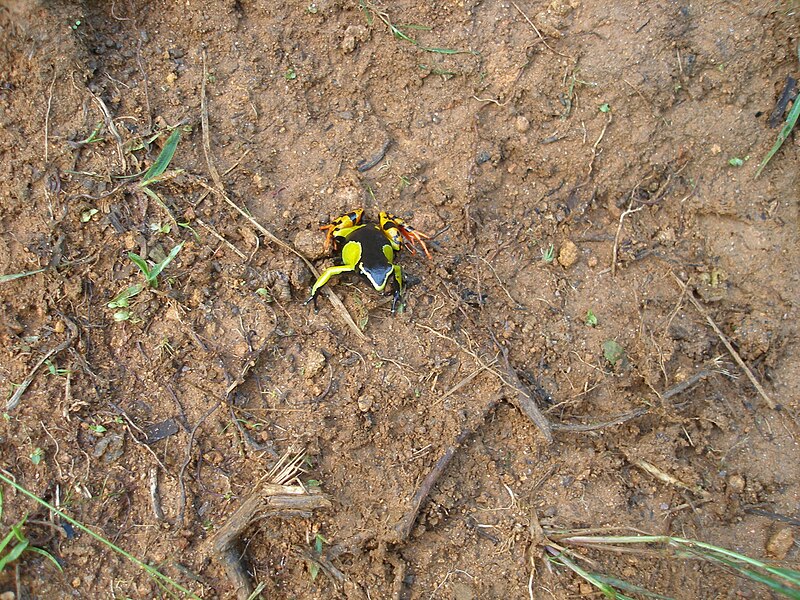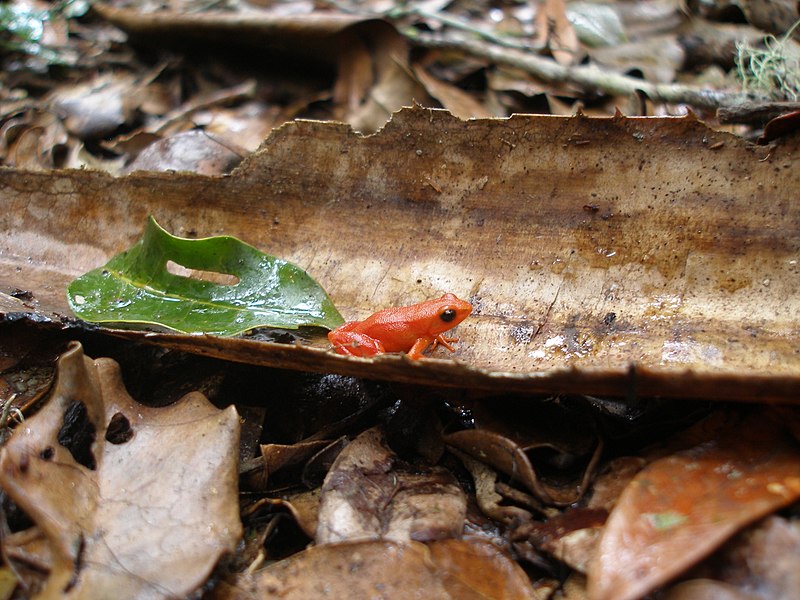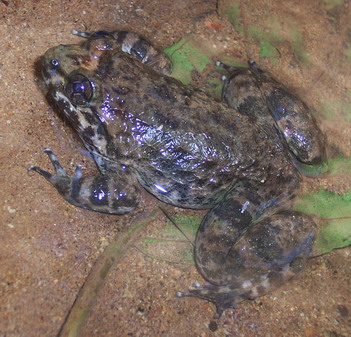Live plants are very useful in creating amphibian terrariums that are both attractive to the eye and beneficial for the animals housed therein. However, amphibian skin is permeable to substances as small as oxygen molecules. Several readers have recently questioned whether pesticides used on terrarium plants could harm amphibians through physical contact.
Examples of Contact Poisoning
 Most chemicals do readily penetrate the skin of frogs and salamanders and can kill them in short order. Pesticides on plants are a concern, even though they will not be consumed.
Most chemicals do readily penetrate the skin of frogs and salamanders and can kill them in short order. Pesticides on plants are a concern, even though they will not be consumed.
A coworker of mine once lost a group of Blomberg’s Toads and Smoky Jungle Frogs after confining them to quickly-rinsed enclosure that had been cleaned with Nolvasan, and I witnessed a Leopard Frog expire after being put into a pail that had previously housed a Fowler’s Toad (the stressed toad had apparently released skin toxins).
Locating Safe Plants
Some commercial growers who cater to zoos and the pet trade claim not to use pesticides. The reptile department of your local zoo, if reachable, might be a good place to start when searching for reputable plant suppliers. Pet stores specializing in tropical fishes usually buy pesticide-free plants as well. Some, especially those that carry plants for outdoor ponds, may stock emergent species or others suitable for use with amphibians.
Removing Surface Pesticides
If you are unsure of pesticide presence, discard the soil that arrived with the plant and rinse the plant, roots and all, vigorously. Finish up by submerging the plant and swishing it about underwater. Some recommend a light soap solution, but I have not found this to be necessary.
Systemic Pesticides
A greater potential concern is posed by systemic pesticides, which do not remain on the surface but rather work their way into the plant’s tissues. Fortunately, these are not commonly used with on commercially raised plants suitable for terrariums.
One colleague of mine did run into a situation involving systemic pesticides. He held the plants for 30 days before introducing them to his exhibits. He had no problems with any of several tree frog species that utilized the plants frequently, and eventually used them with arboreal salamanders (Bolitoglossa spp.) as well. This time frame is based on observation rather than rigid testing, but has proven quite dependable.
Further Reading
Those who keep herbivorous turtles and lizards also need to be concerned about potentially lethal plants. The species listed in my article Common Plants that are Toxic to Birds should be avoided by herp keepers as well.
To learn about growing safe plants for herbivorous reptiles, please see Reptile Gardens.
 That Reptile Blog – Reptile, Amphibian and Exotic Pet Care and Information
That Reptile Blog – Reptile, Amphibian and Exotic Pet Care and Information

 Madagascar’s Mantellas or Golden Frogs (Family Mantellidae) are, in many ways, the ecological equivalents of Latin America’s Poison Frogs (Family Dendrobatidae), and illustrate nicely the concept of convergent evolution – unrelated animals from different parts of the world that have developed similar adaptations. Although less commonly kept than the poison frogs, these tiny, brilliantly-colored gems are gaining in popularity. Following is a brief overview of the group.
Madagascar’s Mantellas or Golden Frogs (Family Mantellidae) are, in many ways, the ecological equivalents of Latin America’s Poison Frogs (Family Dendrobatidae), and illustrate nicely the concept of convergent evolution – unrelated animals from different parts of the world that have developed similar adaptations. Although less commonly kept than the poison frogs, these tiny, brilliantly-colored gems are gaining in popularity. Following is a brief overview of the group. Mantella reproductive strategies roughly follow those of the Poison Frogs. Males call during the day from exposed sites on land – light markings on the vocal sacs may serve as a visual stimulus to females. They wrestle for dominance, with the loser being flipped onto his back but otherwise unharmed. Ten to thirty eggs, which are fertilized externally, are deposited in nests below leaf litter.
Mantella reproductive strategies roughly follow those of the Poison Frogs. Males call during the day from exposed sites on land – light markings on the vocal sacs may serve as a visual stimulus to females. They wrestle for dominance, with the loser being flipped onto his back but otherwise unharmed. Ten to thirty eggs, which are fertilized externally, are deposited in nests below leaf litter. The newly discovered frog is largely aquatic, and apparently catches birds that come to the water’s edge to drink – quite a unique feeding strategy for a frog (I once saw a surprising film of African Side-necked Turtles catching doves in this manner).
The newly discovered frog is largely aquatic, and apparently catches birds that come to the water’s edge to drink – quite a unique feeding strategy for a frog (I once saw a surprising film of African Side-necked Turtles catching doves in this manner). Many amphibian websites tend to focus only on popularly kept species. Today I’ve compiled a list that addresses both common species and less well-known topics, such as amphibian health care and caecilian husbandry.
Many amphibian websites tend to focus only on popularly kept species. Today I’ve compiled a list that addresses both common species and less well-known topics, such as amphibian health care and caecilian husbandry.